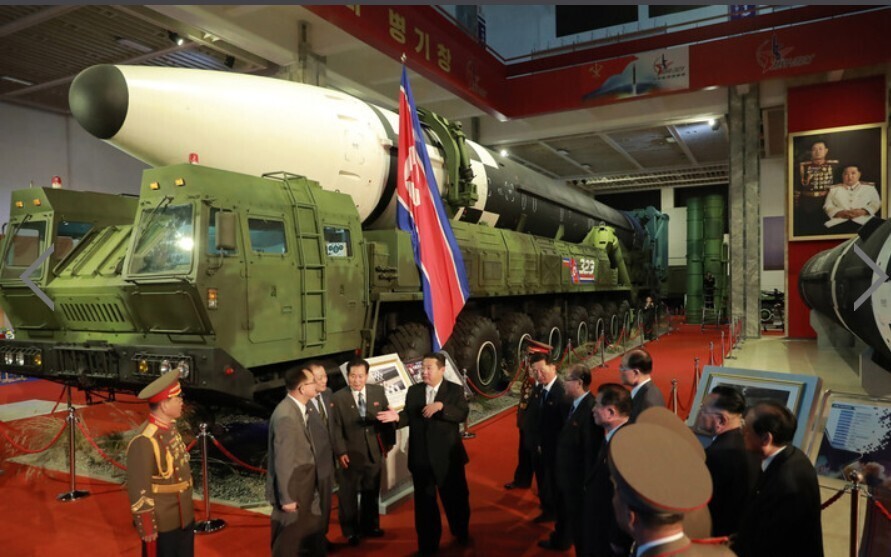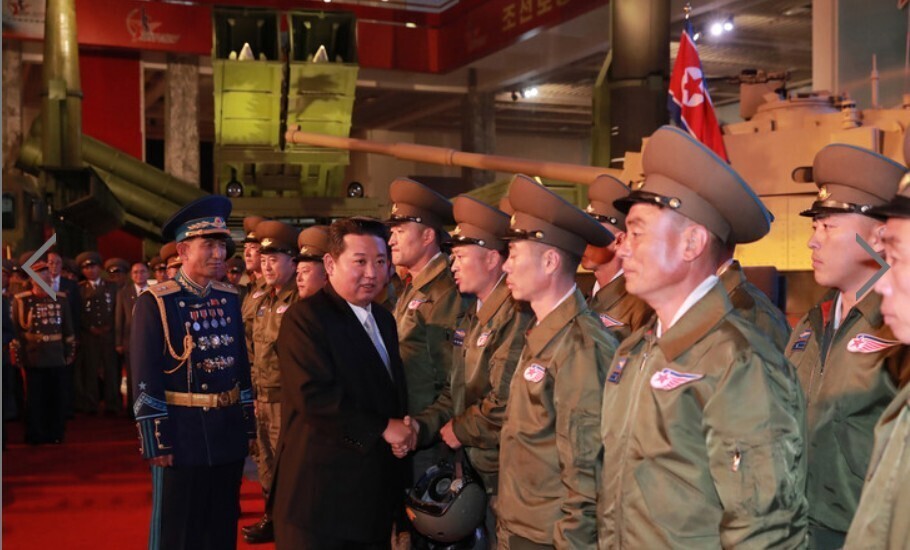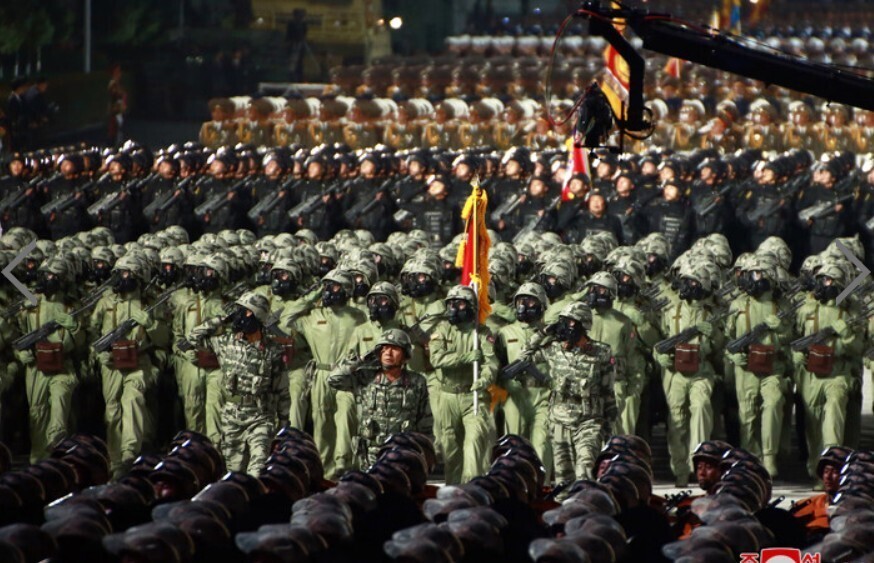hankyoreh
Links to other country sites 다른 나라 사이트 링크
Why N. Korea chose a defense exhibition over a goose-stepping parade this year

For the 76th anniversary of the founding of its Workers’ Party of Korea (WPK), North Korea staged a defense development exhibition titled “Self-Defence 2021.”
It marks the first time the North has opted to show off its military capabilities through an exhibition, rather than the military parade it has conducted in past years. In a commemorative speech for the exhibition Monday, North Korean leader Kim Jong-un said, “Today's grand-scale exhibition, a crystallization of our Party's revolutionary defence policy and its robust viability, is an epoch-making demonstration of our national strength no less significant than a large-scale military parade.”
For the exhibition, North Korea gathered the key weapons it has been developing over the past five years. They included new tank models, a super-large multiple rocket launcher, intermediate- and short-range missiles, what appeared to be a submarine-launched ballistic missile, and an intercontinental ballistic missile (ICBM).
Particularly notable were the hypersonic missile Hwasong-8, which the North claimed to have tested last month, and a new model of surface-to-air missile. They are weapons that, once deployed, could potentially threaten South Korea, the US and Japan.
The South Korean Ministry of National Defense (MND) announced Tuesday that it was analyzing the North Korean military’s weapons and equipment on display at the exhibition.
In a regular briefing that day, MND deputy spokesperson Moon Hong-sik said, “South Korean and US intelligence authorities are already analyzing the equipment shown at the exhibition, and they plan to continue examining it closely.”

The North previously unveiled similar weapons at a late-night military parade held in October 2020 to commemorate the WPK’s 75th anniversary. The event was quite provocative at the time.
In addition to strategic weapons such as ICBMs, the parade packed Kim Il-sung Square in Pyongyang with 22 mechanized companies and 53 files of soldiers goose-stepping in their military boots. It was a tremendous spectacle.
Pyongyang’s decision to hold an exhibition rather than a large-scale military parade appeared to have the aim of showing off military force while bolstering the image of North Korea as a “normal state.” In effect, it advertised the need for stronger defensive capabilities at home and abroad through the exhibition format, which is recognized by the international community as an ordinary form of economic activity.
It also bolstered its own recent demands to stop applying a double standard — where its own missiles are seen as “provocations,” while South Korean missiles are referred to as a “deterrent” — by avoiding a parade as a form of military activity regarded as provocative by the outside world.
Apart from special occasions, Western countries do not stage large-scale military parades. Since World War II, military parades have mainly been carried out by socialist countries — but in the West, they are widely associated with backwardness, belligerence and totalitarianism.
In South Korea’s case, large-scale military parades were held in Seoul’s Yeouido neighborhood for Armed Forces Day every October during the military dictatorship, which lasted through the 1980s. Military parades extended as far as the center of Seoul, north of the Han River.
But after the arrival of the Kim Young-sam administration in the 1990s, they were drastically downscaled or canceled outright.
The former Soviet Union was the originator of the large-scale military parade. During World War II, the armed forces of Nazi Germany advanced all the way to 20 kilometers (12.4 miles) outside of Moscow on Nov. 7, 1941. At a time when the fate of the Soviet Union seemed to be in jeopardy, a large military parade was held at Red Square that day to commemorate the 24th anniversary of the Russian Revolution.

After the dazzling display was over, Soviet troops raced to the front lines on the outskirts of Moscow. The people of Moscow drew great courage from the sight.
The military parade at Red Square served to show off the strength of the previously shambolic Soviet military to viewers at home and overseas. It also contributed to turning the tide toward the Soviets’ eventual victory in their war with Germany.
After World War II ended and the Cold War began, socialist countries like the Soviet Union, China, North Korea and the nations of Eastern Europe actively adopted large military parades as a means of boosting military morale and reinforcing the bonds between the military and civilians. The parades invariably featured goose-stepping: a form of marching in which soldiers armed with various weapons would swing their legs up at a 90-degree angle.
With its latest exhibition, North Korea appeared to be seeking effects in terms of both stronger defense capabilities and economic development.
In the US and throughout Europe, defense companies hold various weapon exhibitions throughout the year to show off firepower and offer counseling on weapon sales. South Korea has its DX Korea land forces equipment exhibition, a combined military/civilian-use technology fair, the Ground Forces Festival, and a combined air show/international aviation and defense industry event known as the International Aerospace & Defense Exhibition (ADENIX).
By adopting the exhibition format, North Korea is looking to leave behind its reputation for “belligerence” and “provocation” while still parading its weapons — that is, its national strength — for a domestic and international audience.
Some distant day, when the sanctions on North Korea have been lifted and it establishes itself as part of the international community, this exhibition could serve as a platform for a defense economy promoting and exporting North Korean weaponry.
By giving it the title “Self-Defence 2021,” the North seemed to be suggesting that it plans to hold similar exhibitions for a long time to come.
By Kwon Hyuk-chul, staff reporter
Please direct questions or comments to [english@hani.co.kr]

Editorial・opinion
![[Guest essay] Amending the Constitution is Yoon’s key to leaving office in public’s good graces [Guest essay] Amending the Constitution is Yoon’s key to leaving office in public’s good graces](https://flexible.img.hani.co.kr/flexible/normal/500/300/imgdb/original/2024/0416/8917132552387962.jpg) [Guest essay] Amending the Constitution is Yoon’s key to leaving office in public’s good graces
[Guest essay] Amending the Constitution is Yoon’s key to leaving office in public’s good graces![[Editorial] 10 years on, lessons of Sewol tragedy must never be forgotten [Editorial] 10 years on, lessons of Sewol tragedy must never be forgotten](https://flexible.img.hani.co.kr/flexible/normal/500/300/imgdb/original/2024/0416/8317132536568958.jpg) [Editorial] 10 years on, lessons of Sewol tragedy must never be forgotten
[Editorial] 10 years on, lessons of Sewol tragedy must never be forgotten- [Column] A death blow to Korea’s prosecutor politics
- [Correspondent’s column] The US and the end of Japanese pacifism
- [Guest essay] How Korea turned its trainee doctors into monsters
- [Guest essay] As someone who helped forge Seoul-Moscow ties, their status today troubles me
- [Editorial] Koreans sent a loud and clear message to Yoon
- [Column] In Korea’s midterm elections, it’s time for accountability
- [Guest essay] At only 26, I’ve seen 4 wars in my home of Gaza
- [Column] Syngman Rhee’s bloody legacy in Jeju
Most viewed articles
- 1[Guest essay] Amending the Constitution is Yoon’s key to leaving office in public’s good graces
- 2Faith in the power of memory: Why these teens carry yellow ribbons for Sewol
- 3[Guest essay] How Korea turned its trainee doctors into monsters
- 4[Editorial] 10 years on, lessons of Sewol tragedy must never be forgotten
- 5Korea ranks among 10 countries going backward on coal power, report shows
- 6Final search of Sewol hull complete, with 5 victims still missing
- 7How Samsung’s promises of cutting-edge tech won US semiconductor grants on par with TSMC
- 8Pres. Park an accomplice in ordering resignation of CJ Group vice chairman
- 9[News analysis] Watershed augmentation of US-Japan alliance to put Korea’s diplomacy to the test
- 10K-pop a major contributor to boom in physical album sales worldwide, says IFPI analyst